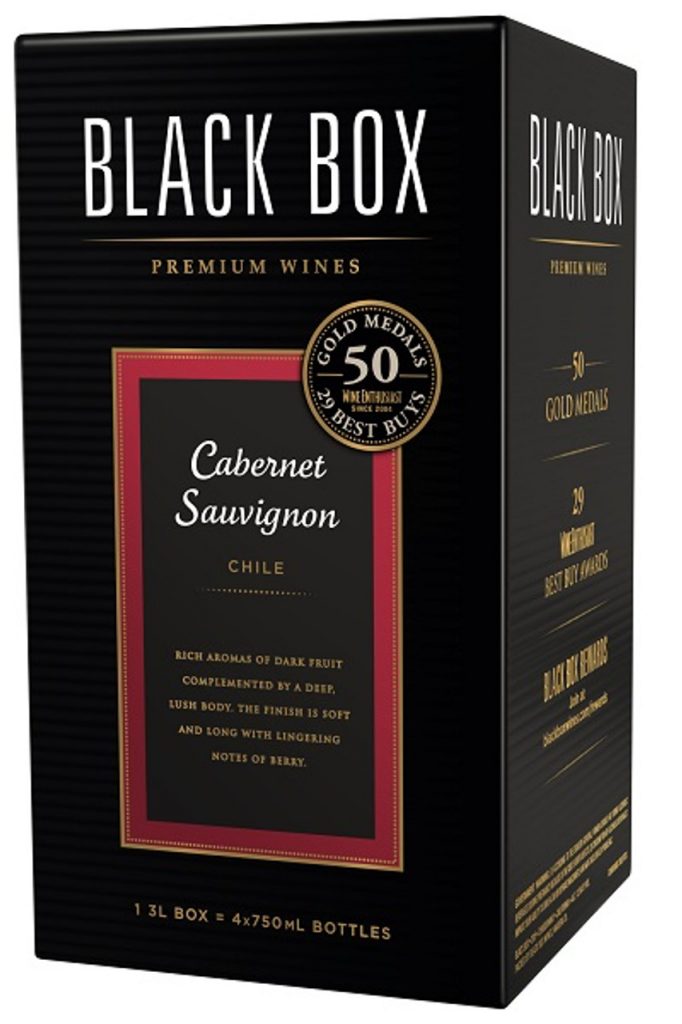The rising demand for eco-friendly and sustainable packaging of all types of food, beverages, and consumer products has led to the adoption of alternative packaging options in the wine industry, once almost the exclusive province of 750 ml heavy glass bottles with cork closures. Catering to consumer preferences for convenience, portability and sustainability, alternative packaging has changed the wine industry, and the arrival of the Covid-19 pandemic almost certainly increased their use. Here are some of the alternative packaging types, either well-established or gaining consumer popularity across the U.S.
Bag-In-Box:

BIB wines have been around for well over a decade and have slowly gained popularity, primarily based on convenience, value, and “eco-friendliness.” I wrote about them way back in 2009 when I visited the Wines Unlimited show in Pennsylvania, and stopped by the booth of Chicago’s Scholle Company, which makes BIB packaging, and was featuring Black Box Cabernet, which I tasted and surprisingly enjoyed. As the public increasingly pays attention to carbon footprints, the box wine industry can rightly claim to have much smaller feet—and can point to several other advantages over bottles, such as no worries about cork taint; easy storage and transport; and a shelf life of up to 6 weeks, as the liner or “bag” inside collapses as you drink, keeping air out. The “average” boxed wine contains 3 liters—the equivalent of four bottles—so you can imagine how much cost, weight, and emissions from production and transportation are being eliminated. These days the wines are much better and far more consistent than 13 years ago, with prices I’ve seen ranging from $23 to $65, from the classic varietals of Chard and Cab, to less-well-known grapes like Grüner Veltliner, to interesting white and red blends. Some popular brands are Really Good Boxed Wine, Communal Brands, Bota Box, and Bota Box Breeze (lower alcohol, carbs, and calories).
Tetra Pak

A Tetra Pak carton is a single-use beverage container. In addition to finding wine in Tetra Paks, your kids often drink their juice or milk from them, and you’ll also find other many other soft or liquid foods and beverages available. They’re lightweight, durable and flexible, and easily stored. They offer excellent shelf like of a year or more, preserving the wine’s flavors and aromas, with a six-layer construction impervious to light. Popular storage sizes include 500 ml and 1.0 liter, and popular brands include Bandit, Vendange, and French Rabbit. While Tetra-Paks are becoming more popular quickly, there may be a couple of downsides. First and foremost, some wine experts contend that the composition of the liner can adversely affect the flavor or the wine. I’m looking for some peer-reviewed evidence of that, but it doesn’t sound impossible. The other issue is that, while they are technically recyclable, their multi-layer, multi-material construction including polyethylene, paper, and aluminum makes that process difficult and expensive, and they are far more likely to end up in landfills.
Cans

Wine in cans has recently gained popularity with younger consumers who prefer convenience and portability. Wine cans are relatively lightweight, easy to transport, and have at least a year or more shelf life; and once opened they’re typically consumed in one serving (and they’re not resealable, in practical terms). The most popular size appears to be 375 ml—half a standard bottle—although some such as Sofia Coppola’s California Sparkling “Minis” are just 187 ml (6.6 oz.), and 125 ml (4.39 oz) and 200 ml (7 oz.) sizes are available if less popular. They’re generally recyclable, and are very customizable, supporting unique designs and memorable branding. Very popular brands include Dark Horse and Underwood. I’ve found that there are more roses, whites, and sparklers typically on shelves than reds, though you can certainly find good reds such as House Wine’s Original Red Blend. I wouldn’t be looking for any Bordeaux Premier Grand Crus any time soon. But I never say never.
Plastic Bottles and Pouches:
Plastic bottles represent a less popular, though slowly growing packaging trend in the wine industry. Pouches are harder to find; they have a spigot like a BIB or a pour at the top and typically hold 1.5 liters=two standard bottles. Some interesting brands include Bonfire Wines, Maivino Wines, and Irreverent Wine. Bottles are typically made from polyethylene terephthalate, or PET; they’re lightweight, all but unbreakable, and recyclable, though after a few cycles they lose integrity and must be downcycled into other products such as carpet padding and clothing materials. They have a short shelf life of around six months to a year, after which the wine may quickly deteriorate from oxygen getting in. France’s Boisset Family Estates was among the pioneers of packaging wine in plastic bottles, years after a U.S. visit when the founder marveled at the use of plastic bottles for mustards. He then began packaging some Beaujolais Nouveau and Red Rhone in PET bottles, with Stelvin closures. Although PET bottles dominate the 187 ml segment, such as Sutter Home 4-Pack “Minis, others such as Nomen Wines and the UK’s Kissing Tree Wines are available in standard 750 ml bottles.
To be sure, wine in traditional bottles with cork closures and foils isn’t going away anytime soon. But with these many other formats and sizes, a new generation of consumers get more convenience, portability, better storage options, and shelf lives that correspond with their purchase and drinking habits. And they can save money and improve product sustainability in the process.
